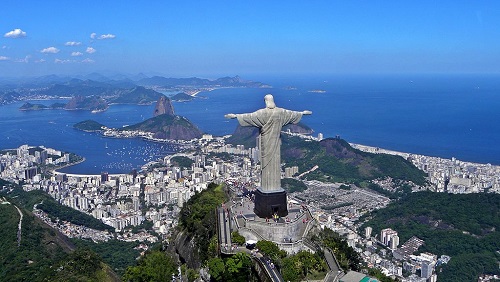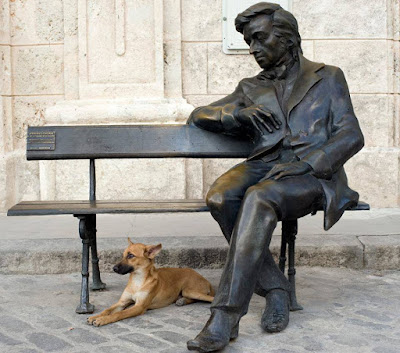It is strange, with American Polonia being so patriotic and so attached to the Old Country, to find such a dearth of Chopin monuments in the U.S. So far, Cleveland, Buffalo, and Chicago are on the list.
Cleveland, Ohio, U.S.A.
We all have set on a bench with someone: I keep visiting Benjamin Franklin in Santa Barbara, but have not yet rested next to Fryderyk Chopin in Havana, in the Plaza de San Francisco, just opposite the former home of the Marquis of San Felipe and Santiago. The simple and modern Chopin Bench encourages passers-by to rest a while with the peaceful, serene composer. In the photo a dog decided to take a break at his feet. How homely and sweet. A good reason to go to Havana and hang around with the bronze Chopin. Note the turned head, inward glance, and the long pianist’s fingers of the right hand splayed in a gesture that reflects a chord or a phrase „heard” by the composer capturing music as it is born, in statu nascendi.
Adam Myjak is a famous Polish sculptor, who graduated from the Academy of Fine Arts in Warsaw and has been elected its President (Rector) for the fifth term, starting in 1990. Myjak is a professor of sculpture in Warsaw and Lublin, and has held over 70 individual exhibitions around the world. His work is found in major museum collections and in public spaces in Poland and abroad. In 2005, he received the highest artistic distinction in Poland, gold medal Gloria Artis. His sculptures are monumental, dramatic and expressive; the quiet, welcoming Chopin seems an exception, rather than a rule…
What piece would fit with the mood of this sculpture? Perhaps a Waltz (Op. 64, No. 2, in C-sharp Minor, played by Evgeny Kissin), or an Etude (Op. 10, No. 3, in E Major, played by Maurizio Pollini)? The Etude, with one of the most memorable Chopin’s melodies, seems more appropriate.
And here’s another image of Chopin sitting on the bench, this one a 1936 photo-montage, published in Poland: „Chwila wytchnienia. Chopin” ( A moment of respite. Chopin) – fotomontaż, by Levitt and Him that appeared in „Wiadomości Literackie” on December 4, 1936. Of course, Chopin never left his wind-swept willow to sit on a nearby park bench…
Guadalajara, Mexico
Even Guadalajara in the state of Jalisco, Mexico, has its Chopin statue. The Monumento a Federico Chopin is located in Jardín Chopin on Avenue Alcalde (colonia de Barranquidas), 44260 Guadalajara, Jalisco, Mexico. It was unveiled in 2001 to honor the beloved composer, described as the father of modern music, a romantic, poet of the piano, and an artist apart.
Chopin is a serious father-figure here, erect, foreboding, with the dry air of a Master, like J.S. Bach in his powdered wig… He is frowning, with eyes reduced to narrow slits looking straight ahead, without a smile. Perhaps it is the cold: his elongated, elegant fingers hold the collar of his jacket upright, wrapped tight around his neck. Here is an image from the freezing land of blizzards and snow right in the middle of a Mexican park. Unfortunately, I do not know if the sculpture is of the full figure, or just the bust. It appears the former. Its rough „unfinished” texture indicates its modernist provenance and aesthetics.
SOUTH AMERICA
According to an article from The Warsaw Voice (July 2003), 130 monuments connected with Poland are located in South America. The majority are in Brazil (61) and Argentina (36); with smaller numbers in Peru (10), Chile (7), Uruguay (7), and Mexico (5). Apparently, Nicaragua has two Polish-themed monuments while Guatemala and Colombia have one each.
Six of these monuments are dedicated to Frédéric Chopin; they may be found in Brazil, Argentina, and Chile.
Rio de Janeiro, Brazil
The oldest monument of Chopin in South America was built in 1943 and unveiled in 1944 in Rio de Janeiro. It was designed by August Zamoyski, Polish sculptor who spent the war years in Brazil but returned to France afterwards. Count Zamoyski (June 28, 1893 in Jabłoń, Poland – May 19, 1970, Saint-Clar-de-Rivière, France) was a member of Polish art groups Bunt and Formiści. His stone compositions, initially influenced by cubism and futurism, were characterized by simple, geometric form, with classical leanings.
The lone figure of the composer lost in thought, looking across the ocean back at his home thousands of miles away, stands on the beach, near the famed Sugar Loaf mountain. In well-fitted, elegant evening clothes (the bronze is wearing out, due to salt in the air), Chopin turns his back at the New World and longs for the lost homeland, far, far away…
The emotional „tone” of the image is also well attuned with the mood of Chopin’s nostalgic and sorrowful mazurkas. The position, turned away from the world, bent over to look inward, in solitude at the edge of the ocean, also captures the personal, intimate, individual tone of Chopin’s music. It is my favorite monument and one day, I’ll go to Rio de Janeiro and stand on the shore of Playa Vermelha, right next to Chopin, lost in thought, an exile in the New World.
Let’s listen to some Mazurkas, then: the most nostalgic, in A Minor, Op. 17, No. 4, as played by a Polish emigre pianist, Arthur Rubinstein, or in A Minor, Op. 7, No. 2 played by Henryk Sztompka:
[youtube_sc url=KsVa18NzdW0]
Porto Alegre, Brazil
In 1963, a monument of Chopin was created by Fernando Corona for Porto Alegre in southern Brazil; it was unveiled on 15 November that year. For those who have not been to Brazil (including me), Porto Alegre is the capital and largest city in Brazil’s state of Rio Grande do Sul, the southernmost part of the country.
The sculpture is actually a portrait of the composer, placed on a simple square granite column with the appropriate inscription marking the anniversary the monument is celebrating: 1810-1960, the 150th anniversary of Chopin’s birth. The Polish composer is recognizable by his long hair and the unique hair style, but the face does not seem to be modeled on any of his known portraits. What seems quite authentic, though, is the expression of sorrow, so typical in images of this most romantic among the romantics.
Interestingly, the best-known Polish-themed monument in Brazil is not of Chopin at all. It is the statue of Christ the Redeemer (Cristo Redentor) in Rio de Janeiro.

A panoramic view of the statue at the top of Corcovado Mountain with Sugarloaf Mountain (centre) and Guanabara Bay in the background. by Artyom Sharbatyan. Wikimedia Commons.
This 37-meter high sculpture was designed by Paweł Maksymilian Landowski. Having graduated with a fine arts degree in Paris, Landowski became the official sculptor of the Third French Republic. He was the creator of the tomb monument of Ferdinand Foch, Marshall of Poland and France, built in 1937 in Hôtel des Invalides in Paris. Landowski’s monument—weighing 1,145 tonnes and unveiled in Rio de Janeiro in 1931—has become a symbol of Brazil.
Buenos Aires, Argentina
In 1944, a Chopin monument was unveiled in Buenos Aires, Argentina. This appears to be the work of Polish exiles that found their temporary shelter in the New World. These included Polish composer and conductor Grzegorz Fitelberg (1879-1953), so perhaps some information about this monument could be found in his biography? The outbreak of the war found him in Paris from where he traveled to Buenos Aires a year later. He worked as a conductor for the Teatro Colón in the 1940-41 season, but later moved north to the U.S. He worked mainly on instrumentation and conducting, and performed in cities such as New York, Montreal and Toronto.
I found a photo of the Chopin bust, with his name „Chopin” carved under the image, in an album of 415 sculptures and monuments of Buenos Aires on Picasa Web Albums. Located in Parque Chacabuco – Av. Asamblea and Emilio Mitre, this sculpture is in a bad need of some TLC: graffiti cover the base and climb up to his evening jacket. The elegant man in a bowtie and with a stern expression under a well-coifed hair is ready for a concert. But is it really Chopin? It could have been any of the Grand Masters, a Schumann perhaps, or a Brahms…
It does not seem that the sculptor knew many images of Chopin nor that he had any other purpose of portraying the Polish composers than adding him to the list of illustrious Europeans celebrated in South America. Perhaps a group of local Poles could polish this symbol of musical Polishness? (Sorry, could not avoid the bad pun).
Unfortunately, that’s all I know. Maybe some of my readers can help and send a more detailed account of this sculpture’s history. Let’s conclude a visit to Buenos Aires with a recording by Martha Argerich, who won the International Chopin Competition in 1965. There are so many excellent interpretations: maybe you have time for a lyrical and expressive Ballade (No. 1, Op. 23, in G Minor, 8 and a half minutes), if you want more, how about the series of Preludes, Op. 28 (over half an hour of music) or a Piano Concerto No. 1 (played with a Polish orchestra, Sinfonia Varsovia, conducted by Grzegorz Nowak)? For those with absolutely no time, there is always the two-minute classic 1965 recording of the electrifying performance of the Etude in C Major, Op. 10 No. 1 that gave the unknown Argentinian first prize in a Competition by default skewed towards Slavic men.
[youtube_sc url=C6yfI1vrX_E]
Santiago, Chile
Apparently, another bust of Chopin has been unveiled in the capital city of Chile. The same story, only worse: I do not even know the date.
Thus we traversed the Americas, from the north to the south, finding many more Chopins in the Latin-inspired countries of South America than in the cold, Protestant U.S. Perhaps my sources are missing monuments that I should have known about but do not. Again, a request to my readers.
In the meantime, let’s look up and find Chopin immortalized in the sky, millions of miles away…
As if the Earth was not enough, astronomers honored Chopin among the stars. He does not have a planet yet, but does have a crater on Mercury and has an asteroid dedicated to him: Asteroid No. 3784. This is one of the small bodies orbiting the Sun; neither a planet, nor any of the planets’ moons, nor an active comet. There are millions of asteroids in different sizes, the majority of them located in an orbit between Mars and Jupiter, as shown above. Some scholars speculate that these multiple asteroids are fragments of a destroyed planet that was orbiting in that spot. In any case, it is certain that we owe the extinction of dinosaurs to the collision with an asteroid that fell on Yucatan Peninsula or the nearby Gulf of Mexico 65 millions year ago. . . Hopefully the Chopin asteroid will behave better!
The Asteroid 3784 Chopin was first seen on October 31, 1986, photographed from the Haute-Provence Observatory in France, by Eric Walter Elst, a Belgian astronomer and a prolific finder of asteroids: he spotted over 3,000 of them! We do not know where does it fall on the asteroid scale of sizes reproduced above. The largest of these asteroids, Vesta, is the size of a pea, when compared to a golf-ball of the Moon. Pretty tiny!
Chopin on Mercury
There is another astronomical site dedicated to Chopin: The Chopin Crater on the planet Mercury. With a diameter of 129 kilometers. and located at 65.1°S 123.1°W, this crater was named after the Polish composer by the International Astronomical Union in 1976.
Chopin is in pretty good company here. There are 398 craters named after historical figures from all countries and cultures (see the site Planetary Names: Mercury: Craters). I spotted the names of numerous composers, among writers, poets, artists, painters and philosophers, mostly male. The forty seven composers are: Johann Sebastian Bach, Bela Bartok, Ludwig van Beethoven, Johannes Brahms, Fryderyk Chopin, Piotr Czajkovskij (Tchaikovsky), Aaron Copland, Francois Couperin, Claude Debussy, Anton Dvorak, Duke Ellington, Mikhail Glinka, Christoph Willibald Gluck, Edward Grieg, Percy Grainger, Friedrich Handel, Joseph Haydn, Gustav Holst, Charles Ives, Leos Janacek, Scott Joplin, Krzysztof Komeda, John Lennon, Franz Liszt, Guillaume de Machaut, Gustav Mahler, Felix Mendelssohn, Thelonious Monk, Claudio Monteverdi, Wolfgang Amadeus Mozart, Modest Mussorgski, Sergei Prokofiev, Giacomo Puccini, Henry Purcell, Sergei Rachmaninoff, Maurice Ravel, Domenico Scarlatti, Arnold Schoenberg, Franz Schubert, Jean Sibelius, Bedrich Smetana, John Phillip Sousa, Tansen (from the Mogul Court in India), Giuseppe Verdi, Heitor Villa-Lobos, Antonio Vivaldi, and Richard Wagner.
The list of all musicians I noticed is interesting, in its heavy reliance on the Western canon, with a spattering of „others” – including some jazz musicians. Neither Louis Armstrong, nor Ella Fitzgerald, nor Miles Davis made it to the list. Thelonious Monk and Duke Ellington did, and so did the only Polish composer, besides Chopin, jazz pianist Krzysztof Komeda (who, among other titles, wrote music to Roman Polanski’s film „Rosemary’s Baby”). I wonder who made this list and what criteria were used. It seems that Russians played a major role in selecting these names, and so did the English. Vivaldi but no Palestrina? Verdi, but no Bellini or Rossini? Interesting…
PIA19420: The Ups and Downs of Mercury’s Topography https://photojournal.jpl.nasa.gov/catalog/PIA19420
Measurements from MESSENGER’s MLA instrument during the spacecraft’s greater than four-year orbital mission have mapped the topography of Mercury’s northern hemisphere in great detail. The view shown here is an interpolated shaded relief map of these data.
Chopin in the Garden
Finally, who would forget the living monument to Chopin, that you can plant anywhere on our planet if you have a garden, some soil and some water… The Chopin rose, according to its description by Wikipedia, is also known as ’Frederic Chopin’, and 'Frederyk Chopin’ and is a hybrid tea rose cultivar introduced by Stanisław Żyła in Poland in 1980. This rose was created by crossing the 'Crêpe de Chine’ rose with the 'Peer Gynt’ rose. ’Chopin’ is a strong growing rose (150–200 cm) with showy, large flowers of light cream to pale yellow colour. Flowers have an average diameter of 5 inches (11 cm) and 17-25 petals. They grow in small clusters (3-5), have moderate fragrance and appear in flushes throughout the season. The rose bushes have big, leathery foliage and are winter hardy (USDA zone 6b – 10b) and generally disease resistant….
So let us drink some tea, listen to Chopin’s Berceuse played by Tatiana Shebanova (the most astounding image of a cosmic flight in all his music), and smell the roses!
CC BY-SA 4.0. File:Rose 'Chopin’ MB01.JPG
Created: 5 July 2014. From Wikimedia Commons
______________________________________________
NOTE: Since I have not visited any of these monuments myself, I thank all photography authors and sources of photographs, which are used here in accordance with non-commercial fair use open source principles of Wikipedia, and Wikimedia Commons, from where most of the photos are copied.
Serdecznie dziękujemy Autorce za zgodę na jego przedruk



























